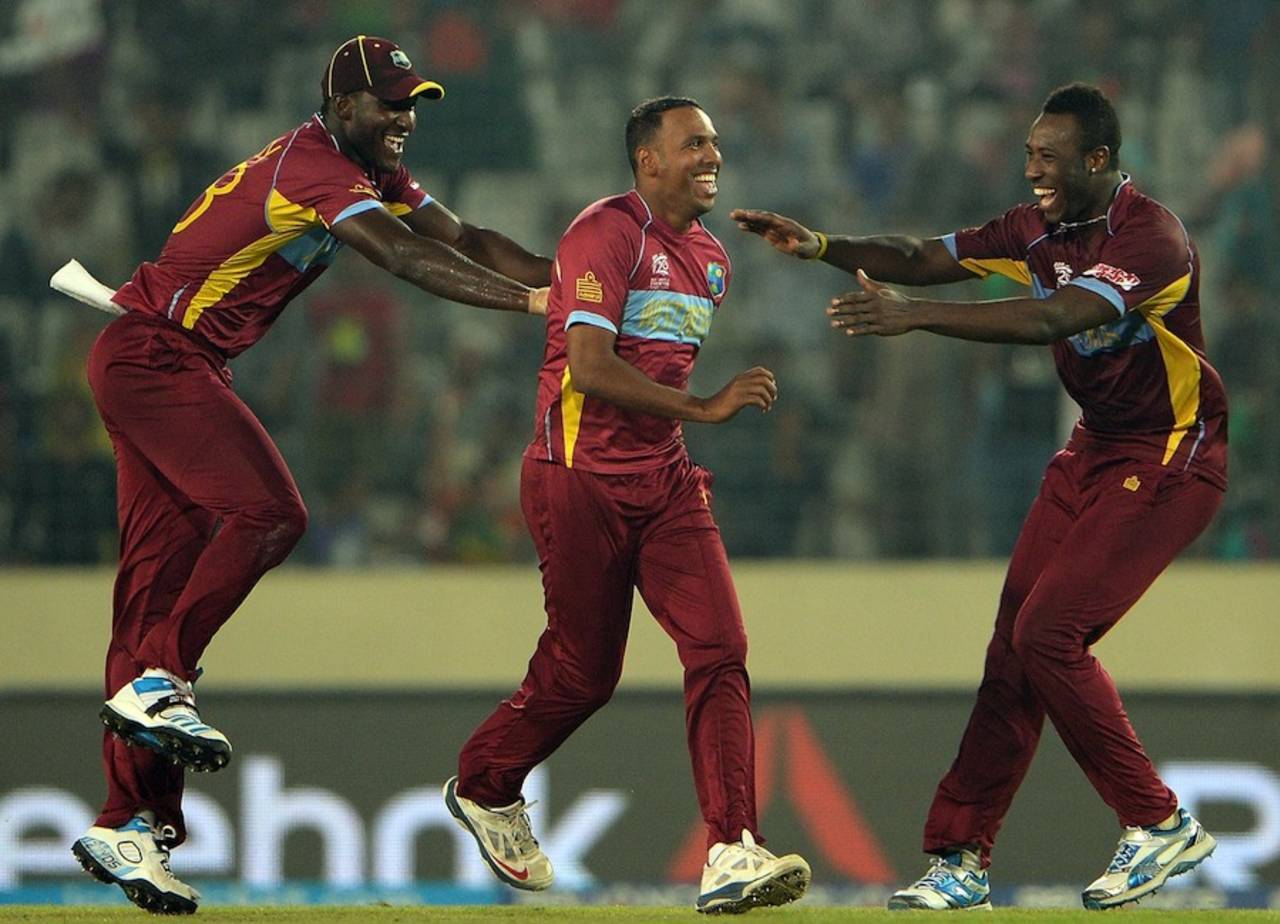Caribbean national sides, anyone?
Why dissolving West Indies might be the best option for West Indies cricket
Martin Jones
07-May-2014

Despite their good recent performances in the World Twenty20, the West Indies are far from a cricketing force these days • AFP
Much as I'm sure everyone hates to admit it, Allen Stanford might well have been onto something. I'm not on about the whole billion-dollar fraud and landing his chopper on the Nursery Ground, I'm on about the West Indian islands fielding national teams.
It seems to be an odd quirk in cricket that the West Indies are united under a single banner for international cricket, similar in fact to east-European sports teams continuing to operate under a Yugoslavian banner. And however rich the cricketing tradition attached to the West Indies team, Coming to America puts it best when Prince Akeem says that "it is also tradition that times must and always do change". It's time that the West Indies changed.
Despite their good recent performances in the World Twenty20, the West Indies are far from a cricketing force these days. They regularly crumble against world-class opposition, and until Darren Sammy got everyone pulling in a similar direction, they went through a stage of struggling horribly for leadership too. Despite this, there are still loud and respected voices calling for Sammy's head with alarming regularity.
The West Indies Cricket Board comprises of six associations, representing Barbados, Guyana, Jamaica, Trinidad & Tobago, the Leeward Islands and the Windward Islands. The Windwards include Dominica, Grenada, St Lucia and St Vincent & the Grenadines; The Leewards include Anguilla, Antigua & Barbuda, Montserrat, Nevis, St Kitts, St Maarten, and the Virgin Islands (both British and American). To co-ordinate these many organisations is a persistent logistical and political nightmare for all concerned.
Allen Stanford claimed that a Twenty20 knockout could reinvigorate cricket in the West Indies. In reality, he was just adding window-dressing to a competition that was at best illicitly-funded, and at worst a money-laundering scheme. Not that anyone was to know that, although perhaps the hosting of every game at the Stanford Cricket Ground indicated that altruism was far from his top priority.
All the same, Stanford got things done, by fair means or foul. His first tournament included nineteen teams, and the second made room for two more, although Cuba never made it onto the field. The format of pitting nation against nation was widely acclaimed as a fantastic initiative, but when Stanford went down in flames, the format burned with him.
West Indian cricket has always been dominated by four nations: Barbados, Guyana, Jamaica and T&T. A look at their player pools reveals precisely why.
Barbados, for instance, have a bowling battery that includes Tino Best, Carlos Brathwaite, Miguel Cummings, Fidel Edwards, Jason Holder, Kevin McClean, Raymon Reifer, Kemar Roach and Javon Searles bowling seam, while Sulieman Benn, Ryan Hinds and Ashley Nurse spin the ball. When you add the batting ability of Kraigg Brathwaite, Jonathan Carter, Kyle Corbin, Kirk Edwards, Omar Phillips and Kevin Stoute, then you get a good, if bowling-heavy, international team.
Guyana, too, showed against Ireland that they could mix it as an international team. Picking eleven out of Trevon Griffith, Shiv Chanderpaul, Assad Fudadin, Ramnaresh Sarwan, Narsingh Deonarine, Leon Johnson, Christopher Barnwell, Derwin Christian, Veerasammy Permaul, Devandra Bishoo, Paul Wintz and Ronsford Beaton gives you a well-balanced and powerful team. Of course, there is more talent also waiting in the wings. For decades, the Berbice-Demerara fixture used to hold first-class status.
Jamaica, meanwhile, have the drawcards. Chris Gayle, Marlon Samuels, Andre Russell - these are the players who fill stadiums. It pays, though, not to forget the likes of Nkrumah Bonner, Chadwick Walton, Carlton Baugh, Tamar Lambert, David Bernard, Jerome Taylor, Sheldon Cottrell, Nikita Miller and Krishmar Santokie. It's no fluke that even when their big names are away playing Twenty20 cricket, Jamaica usually busy themselves with slugging it out against Barbados's bowlers for the Headley-Weekes Trophy. Jamaica have won it six times out of the last eight.
Trinidad and Tobago, though, are the ones that everyone talks about, the ones who grab all the headlines, the ones who play Twenty20 best. Of course, when your player pool includes Adrian Barath, both Bravos, Lendl Simmons, Jason Mohammed, Dinesh Ramdin, Nicolas Pooran, Kieran Pollard, Shannon Gabriel and Rayad Emrit, perhaps this isn't such a surprise. However, the real strength is in the spin department. As well as T20 trump cards Sunil Narine and Samuel Badree, T&T is also home to Ryan Austin, Yannick Cariah, Amit Jaggernauth, Kavesh Kantasingh, Dave Mohammed and Yannick Ottley. On low, turning home surfaces, this is not a friendly proposition. Additionally, the T&T domestic competition also once held first-class status.
But it isn't just the big four nations who would be competitive. Antigua and Barbuda (Austin Richards, Sylvester Joseph, Devon Thomas, Rahkeem Cornwall, Anthony Martin, Gavin Tonge), St Lucia (Johnson Charles, Craig Emmanuel, Keddy Lesporis, Darren Sammy, Garey Mathurin) and St Vincent (Sunil Ambris, Miles Bascombe, Romel Currency, Lindon James, Alston Bobb, Orlanzo Jackson, Delorn Johnson, Keon Peters) would all be testing for top-end Associate sides. The cricketing potential of the West Indies is best unleashed if it ceases to be the West Indies.
If you have a submission for Inbox, send it to us here, with "Inbox" in the subject line
Martin Jones is a teenage swing bowler. He blogs regularly at the Popping Crease, and has an avid interest in the game at all levels.